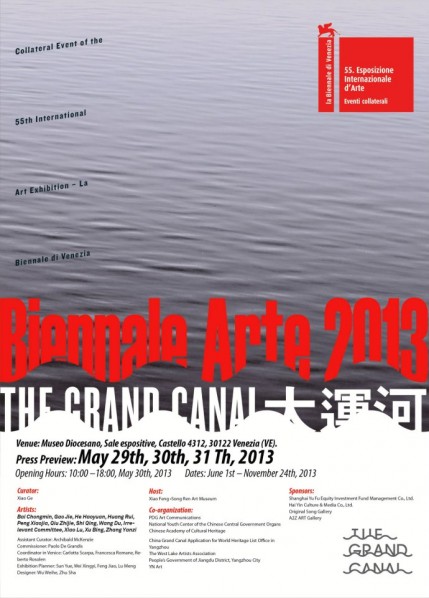
“Grand Canal”, Collateral Event of the 55th International Art Exhibition – La Biennale di Venezia, opens on 1 June 2013 in the Museo Diocesano dell’Arte Sacra on the banks of the Grand Canal in Venice. Twelve renowned Chinese artists were invited to participate, by independent curator and artist Ms Xiao Ge. It is also part of the application for World Heritage listing for the Chinese Grand Canal. Over the following year the canal-related exhibitions and events will be successively held along the Grand Canal in China, as well as in Paris, which aims to contribute to the application.
Both Venice in Italy and Yangzhou in China are cities that grew and flourished on the basis of water-borne trade, and the history of China and Italy is linked in more than one way by their ancient Grand Canals. In the 13th century, the Italian Marco Polo set sail from Venice, arrived in China after four years, and after returning wrote an account of his voyage which includes the Grand Canal from Beijing to Hangzhou, the longest and oldest extant manmade waterway in the world. In the Spring and Autumn Period (8th to 5th century BCE), the digging of the Han Conduit meant that the history of the Grand Canal would always be associated with the ancient city of Yangzhou. In 2006, 58 members of the National Committee of the Chinese People's Political Consultative Conference unanimously started the formal process of the Chinese Grand Canal Application for World Cultural Heritage Listing, and the Chinese Grand Canal Listing Office was established in Yangzhou. In March 2013, a Working Conference for the Chinese Grand Canal Heritage Listing Application was held in Yangzhou, and the Heritage Listing application started its countdown.
To tie in with the Declaration of the World Heritage Listing of the Chinese Grand Canal, and to raise awareness about it and its cultural heritage, the famous oil painter Xiao Feng initiated the execution of a series of “The Grand Canal” exhibitions to be planned by the Xiao Feng – Song Ren Art Center. This received the cooperation and support of the relevant government departments and organizations, thereby mobilizing forces of all sectors of the community towards the success in 2014 of the Chinese Grand Canal World Heritage Listing application.
The bias of this exhibition is towards pluralism and openness, and the selection of works is based on compatibility with the theme of the Exhibition. The twelve well-known Chinese artists were born between 1950 and 1990. They were invited to take part by independent curator and artist Ms Xiao Ge. The types of works exhibited include traditional Chinese painting, installations, video installations, performance art and contemporary art media.
The title of the 55th International Art Exhibition – La Biennale di Venezia is “Il Palazzo Enciclopedico” (the Encyclopedic Palace) – with the aspiration of blending contemporary art with historical tradition in the manner of an encyclopedia. The Grand Canal was dug precisely for such “encyclopaedic” reasons of politics, economics, as well cultural openness, exchanges and transmission.This is consistent with the open spirit of globalization today.
The Manmade River of Openness
by Xiao Ge, Curator
Venice in Italy and Yangzhou in China are both cities that ‘grew from canals’. The Grand Canal between Beijing and Hangzhou (the Jinghang Canal), is the earliest and longest man-made waterway in the world. In the Spring and Autumn Period (c771-476BCE), the Han Conduit was excavated, and the history of the Grand Canal began, ensuring that the name of the ancient city of Yangzhou will live forever. In March 2012, The Working Committee for the World Heritage Application for the Grand Canal was launched in Yangzhou, and the countdown to listing began. On 1 June, 2013, “The Grand Canal” Collateral Event of la Biennale di Venezia opens in the Museo Diocesano di Sant’Apollonia in the romantic water city of Venice. In the 13th century, the Italian Marco Polo set sail from Venice and arrived in China after four years of travelling. Later he provided materials for the famous record of his voyages. Two ancient canals serendipitously link the histories of Italy and China. For Venice, the first stop of our touring exhibition “The Grand Canal”, we have invited 11 renowned Chinese artists and one distinguished artists’ collective) to create contemporary art works designed to promote the success of the 2014 World Heritage Listing of the Grand Canal of China.
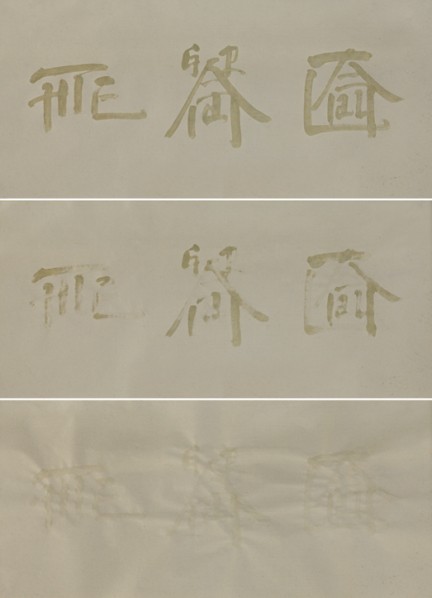
Xu Bing, The Grand Canal, 2013; Water, rice paper, video, 97cm×180cm, Photography Xu Bing's studio in Beijing © Xu Bing
In Xu Bing’ s work Grand Canal, he uses water from the Jinghang Canal to write on xuan paper his own invented “English-Chinese” characters for “Grand Canal”. When the water dries, the traces of the characters gradually fade, leaving behind a wrinkled texture. This subtle metaphor for the Way of respecting natural being and according with heaven according to Chan (Zen) Buddhist wisdom, conveys to the viewer the wonderful space of the imagination in Chinese calligraphy.
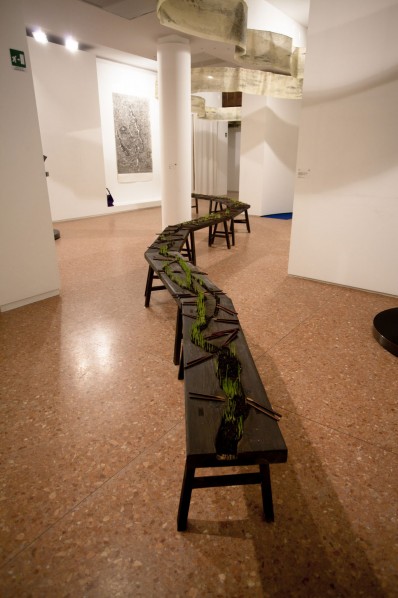
Qiu Zhijie, Canal Transportation, 2013; Wooden Bench, Plant seed, Soil, Chopsticks, Dimension Variable© Qiu Zhijie
In his installation Taming the Waters, Qiu Zhijie has mounted on the dead trunk of a pomegranate tree several metal water tubs with taps that can freely be turned on or off, allowing them to fill or empty with water pumped into the top vat. He sees a connection between the Grand Canal and the “taming of the waters” associated first with the legendary Yu the Great, but also with Emperor Qin Shihuang and with Emperor Yang of the Sui Dynasty. Governing China has at all times been built around water control.
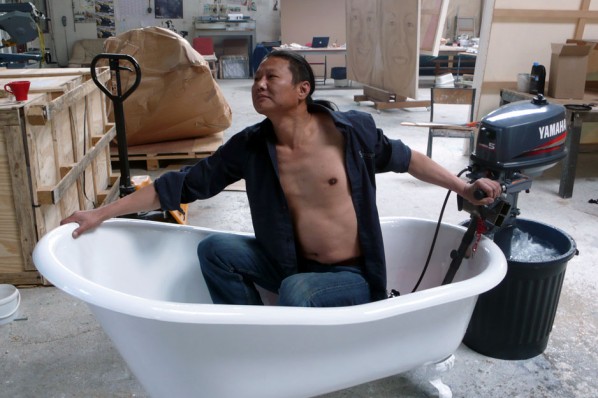
Wang Du, Love in the Time of Cholera (L'Amour aux temps du choléra), 2008; Bathtub, Propeller engine, 180cm×80cm×65cm © Wang Du
Wang Du’s Love in the Time of Cholera (L'Amour aux temps du choléra) refers directly to the novel of the same name by Gabriel García Márquez. A canal that flows with the history and destiny of the nation is the ebb and flow of the changing times and the humanist spirit. Like the experiences of the hero and heroine of the novel, it points out that the only survival instinct of mankind is fearless romanticism and idealism.
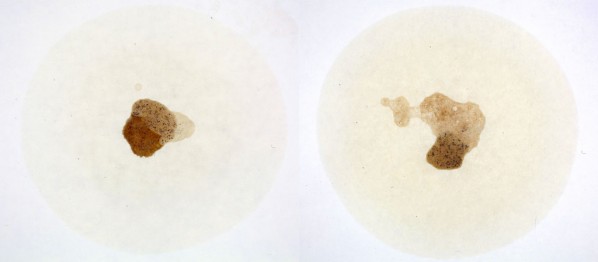
Xiao Lu, Toxins, 2011-2013; Wood, toxin, the Grand Canal silt, 82x82cm © Xiao Lu
Xiao Lu’s Toxinuses toxins expelled by Daoist tuina massage of the energy circulation system, in juxtaposition with sludge from the Grand Canal. Through the chemical analysis of toxins, she suggests that the internal pollution of the human body by the environment is analogous to the external environmental crisis that is besetting the Canal's "energy circulation system" as it were, and indicates that the Grand Canal, just like humanity at present, is in need of detoxification.
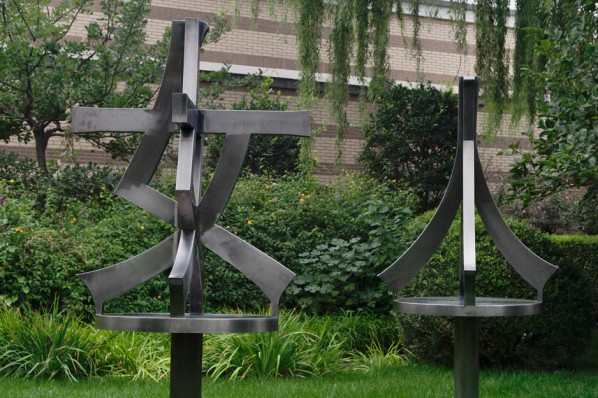
Huang Rui, Women, 2006-2012; Stainless Steel Black Titanium Plate, H223xΦ106cmx2, Version number 67 © Huang Rui
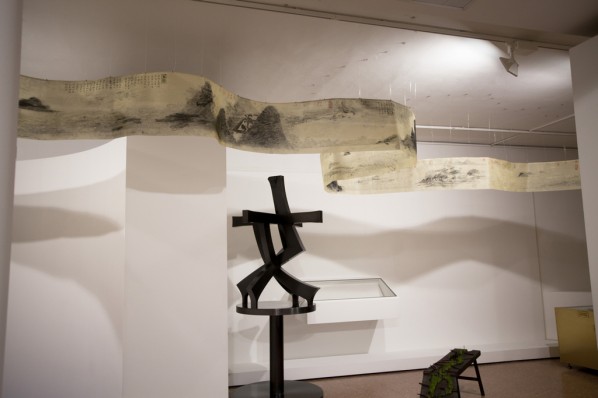
Huang Rui’s Woman is directly derived from the form of the relevant Chinese characters. He likens the Grand Canal to a woman, gentle inside but hard also, full of spirit and irreducibly themselves: “women are women”.
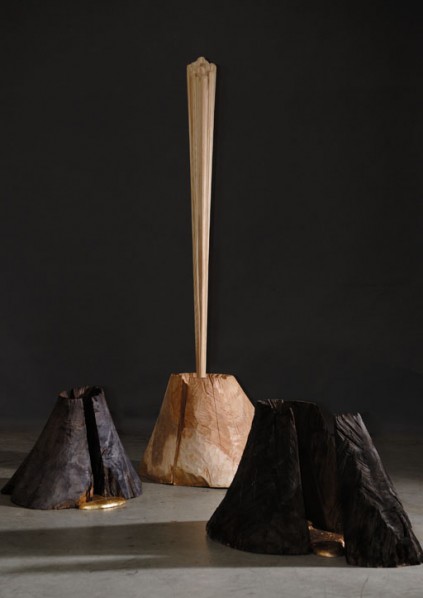
Peng Xiaojia, Landscape Sculpture, 2012; Coloring maple, artificial resin, gilding, Dimension H176cm © Peng Xiaojia
Peng Xiaojia’s Shanshui Landscape, placing the Grand Canal’s sources of running water somewhere between the human excavation of the Canal and the natural environment, shows how they are as closely related as mountains and water are in traditional shanshui painting.
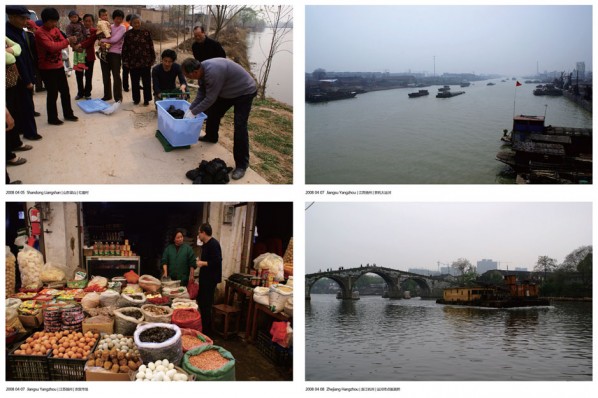
Shi Qing, 1794 km Resources’ Geography of Jinghang Grand Canal, 2008; Pictures, video, food, coal, water, map, gasoline, etc. Dimension Variable © Shi Qing
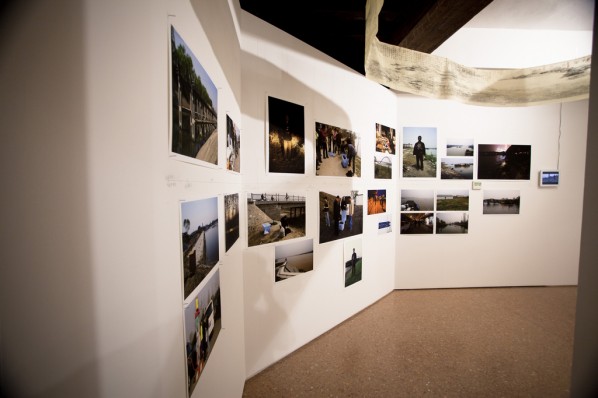
Shi Qing’s 1794 Kilometers: Resources Geography of the Beijing-to-Hangzhou Canal, presents his journey when he drove from the beginning of the Grand Canal in Beijing to Hangzhou in 2008, in the formats of performance, video and photography to explore itinerant practices surrounding the Grand Canal and the trade in resources along the Canal.
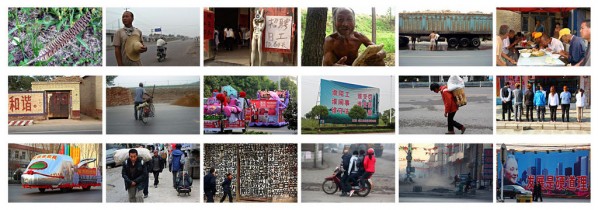
Bai Chongmin, Running A Thousand Miles for An Appointment, June 16, 2011 -February 15, 2012. Materials: Feather
Dimension: Tramped all of ten thousand miles
Photography: Bai Chongmin, Ah Bing
© Bai Chongmin
Bai Chongmin on the other hand used the pretext of Running a Thousand Miles to Keep an Appointment to retrieve poetic notions of the past by walking a thousand miles along the Jinghang Canal and south to Longquan and Kunming honouring appointments to see friends. Persevering for more than 200 days and losing 10 kilos, he produced a photographic record of the life of the people of this stretch of the country from the parallel perspective of his experiences, using a meditative, introspective format to represent China’s current social landscape.

Irrelevant Committee, Living Together, 2013; Materials: The video interview, collected pictures, wire, clothes, toys, fishing nets, water pipes, woven bags, plastic bags, red banners, power cables, waste materials, etc.
Dimension: Variable
© Irrelevant Committee
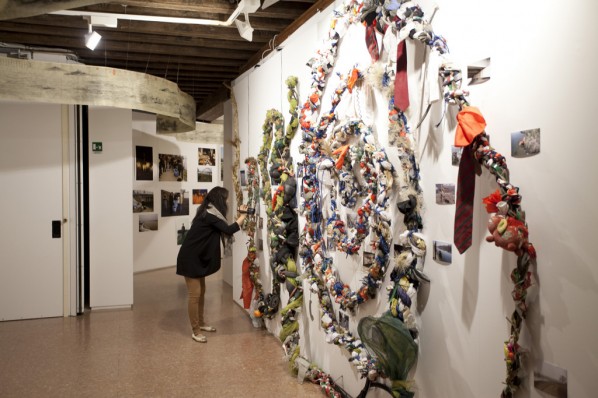
The Irrelevant Commission, or Irrelevant Group, a collective of young artists which tends towards intense social engagement has on this occasion approached the Grand Canals of China and Italy, and by an exchange of, and interaction between, commodities and languages have continued the social survey activities which they have consistently pursued.
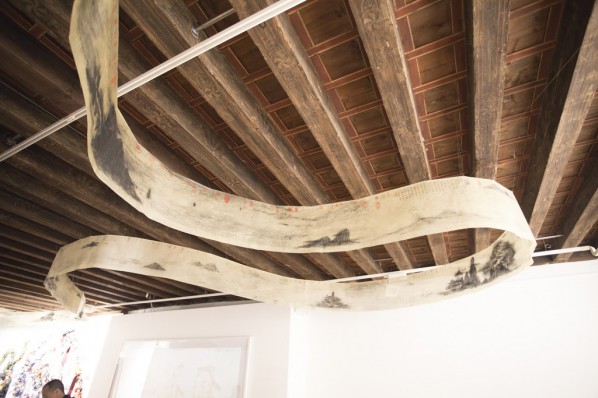




Zhang Yanzi, The Flow of Energy, 2013; Materials: silk, ink and wash, etc.
Dimension: 50cm×6000cm
Photography: Hu Zhiheng
© Zhang Yanzi
Zhang Yanzi’s long scroll Chinese painting Qi/Energy marshals the meridians of the Grand Canal and of the earth and conveys their perennial energy. Is it actually water or energy that flows day and night?
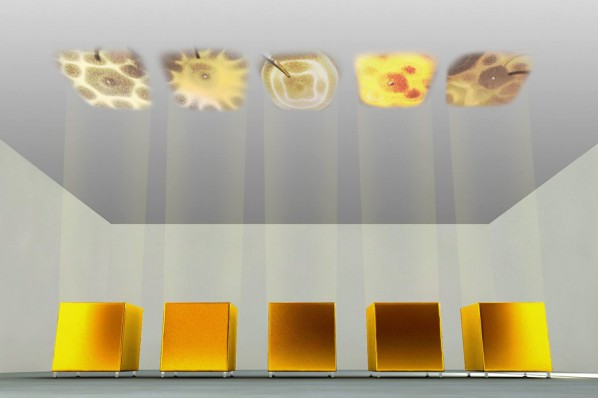
He Haoyuan, In The Beginning - Six Words of Truth, 2013; Dimension: 80x80x80cm x6
© Hao Yaoyuan
He Haoyuan’s In the Beginning series installations uses the sound of prayer, transforming the resonance of its soundwaves into religious images in an exploration of the effects produced by the dissemination via the Grand Canal of Buddhism and Daoism on Chinese culture.
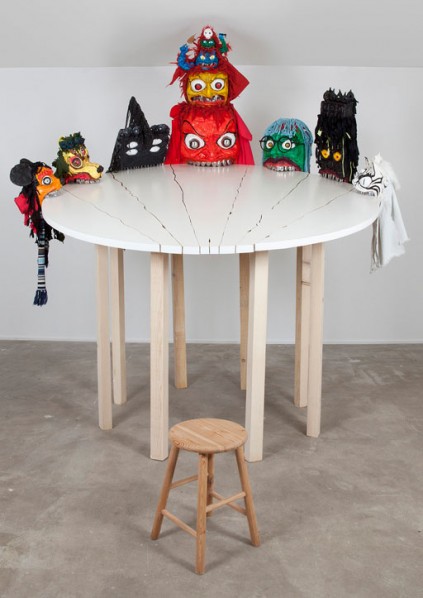
Gao Jie, Be out of Control, 2013; Materials: Wood, parget, clothes, knife, fork, spoon, leaf, card, acrylic paint
Dimension: 230x250x270cm
© Gao Jie
Gao Jie’s Out of Control grows out of ancient and new stories of men, ghosts and spirits along both banks of the Grand Canal, highlighting the confrontation between inner existence and external culture.
The theme of the 55th art exhibition of la Biennale di Venezia is the “Encyclopaedic Palace”, with the aspiration of showing a blending of contemporary art and historical tradition in the manner of an encyclopaedia. The Grand Canal of China was dug precisely for the purposes of opening up, exchanging and disseminating politics, economics and culture. This is in tune with the open spirit of globalization today.
The theme of the “Grand Canal” in a similar way shows the occurrence and development of Chinese contemporary art, its integration with historical tradition, and not only suits the overall theme of la Biennale, but also emphasizes the history and transformation of Chinese society. The “Grand Canal” is a “living” heritage. It is emblematic of the history and destiny of the Chinese nation. It transmits the changing, flowing culture of the ages. When we scrutinize the historical tradition of the Grand Canal using the perspective and expressive forms of contemporary art to allow the world to become re-acquainted with the value of the existence of Grand Canal of China, and with the practical significance of its distant culture, we can take another step in our exploration of how today’s Chinese artists should deal with “being natural”, and how they should deal with their tradition.
Translated by Archibald McKenzie 26 March 2013
About the Curator
Xiao Ge, an artist and curator, was born in an art family of Shanghai in 1971. She graduated from Middle School Affiliated to China Academy of Art and then the Printmaking Department of Central Academy of Fine Arts. In late 1995, Xiao went to France and successively studied in Universite De Provence Aix-Marseille, Oil Painting and Inter Media Art Department ofécole nationale supérieure des Beaux-arts de Paris, Ecole De La Chambre Syndicale De La Couture Parisienne and International Cultural Exchange Department of Université de Vincennes à Saint-Denis, where she received double bachelor’s degrees and double master’s degrees. Xiao returned to China in 2009 and now she lives and works in Beijing.
As an active artist, Xiao has her works represented in France, Italy and China, covering a various forms such as painting, installation and performance. Her main exhibitions include “Hour Rate-Xiao Ge’s Art Exhibition” in International City of Arts (Cité Internationale Des Arts) in Paris, France in 2000, “Parallel World: Lille-Shanghai Express Train” in EU Extravaganza 2004, “International Art Saloon” in Florence, Italy in 2006 and periphery event “Between East and West”of 52nd Venice Biennale 2007.
From 2005 to 2008, Xiao Ge was engaged as a director to the Italian Center in China and participated in planning several international cultural exchange projects. She served as a press officer to “Shanghai Art Fair International Contemporary Art Exhibition” in Asia Pacific region in 2009, and planned the “Warm Winter Project” from 2009 to 2010 as a chief curator, which was called the “biggest event in Chinese contemporary art of 2009” by the mass media and historian. In 2011, Xiao took up the post of vice president to “China Contemporary Art Foundation” and has planned a series of events and exhibitions; then she serves as head of preparatory committee and director of Xiao Feng and Song Rens’ Art Museum in 2012. In the same year, Xiao was invited as a special guest curator for “Zhongshan Park Project” of 9th Shanghai Biennale 2012, and co-curated “On the Way Home – Shanghai Pudong International Airport Special Exhibition.”
About the exhibition
Organizations:
National Youth Center of the Chinese Central Government Organs;
Chinese Academy of Cultural Heritage;
China Grand Canal Application for World Heritage List Office in Yangzhou
The West Lake Artists Association
Co-organization:
People’s Government of Jiangdu District, Yangzhou City
China Social Welfare Foundation (the Green Relief Fund)
National School Children Traffic Safety Education Office
In collaboration with: PDG Art Communications
Sponsors:
Original Song Gallery
A2Z-Art Gallery
Curator: Xiao Ge
Assistant Curator: Archibald Mckenzie
Commissioner: Paolo De Grandis
Coordinator in Venice: Carlotta Scarpa, PDG Art communications, Francesca Romane, Reberto Rosolen
Coordinator in Yangzhou: Guo Peijian
Exhibition planner: Sun Yue, Wei Xingyi, Feng Jiao
Design: Wu Weihe, Zhu Sha
Translation: Archibald Mckenzie/Wen Zai, Sun Yue, Luca Zordan, Lu Meng
Courtesy of The Grand Canal, for further information please visit www.grandcanalart.org.




























